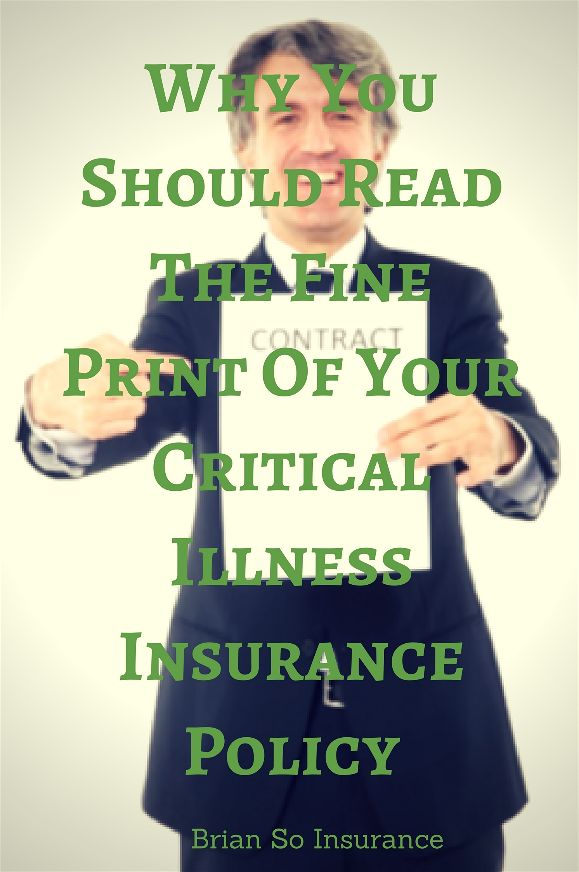
Nobody wants to read fine print. It can be a chore squinting to read thousands of tiny words when the vast majority of its content isn’t applicable to you. But when you purchase something as important as a house, car, or insurance policy, it’s in your best interest to comb over the fine print. What you find may surprise you.
Take a critical illness insurance policy for example. Did you know there are specific definitions for the covered illnesses and exclusions that may prevent you from making a claim? Take full advantage of the 10 day ‘free look’, which gives you a 10 day period to review the contract. If you feel uncomfortable about the definitions and exclusions, you can return the policy to the insurance company for a full refund.
Definition of a critical illness
You are not automatically entitled to a payout if you suffer a cancer, heart attack, or any of the other illnesses listed in the contract. In order to receive a benefit, your illness has to match the definition in the contract. Here is the definition for cancer from an insurance company’s contract:
Cancer means a definite diagnosis of a tumour characterized by the uncontrollable growth and spread of malignant cells and the invasion of tissue. The diagnosis of cancer must be made by a specialist. The insured person must survive for 30 days following the date of diagnosis.
Note that the wording used is very specific. This protects the insurance company from having to pay out on borderline cases, so only legitimate diagnoses of cancer will qualify for a claim. Similarly worded definitions are used for the rest of the covered illnesses. The strength of the policy that you buy largely depends on the definition. A less costly policy may have more restrictive definitions and is less likely to pay out a claim, while one that is more expensive usually has a looser definition, and therefore is more likely to pay.
Since around 85% of claims are paid out on cancer, heart attack and stroke, you should be most familiar with the definitions of those ailments.
Some policies provide a smaller benefit (usually the lesser of 10-25% and $25,000-$50,000) for less severe types of cancer and other ailments. These include stage A (T1a or T1b) prostate cancer, ductal carcinoma in situ of the breast and coronary angioplasty. The treatments for these conditions are less invasive, have shorter recovery periods and will have less impact on the finances of a covered individual, which is why a full payout is unwarranted. Any payment for a covered condition will be reduced by the partial benefit.
In addition to knowing the definitions of the illnesses, you should also be aware that the benefit is conditional on the insured surviving for 30 days following the diagnosis of the condition. You must also report the claim within a certain period of time after diagnosis or risk having the claim denied, although this ranges from 30 days to 1 year among the different insurance companies.
Exclusions
Typical exclusions include suffering an illness while operating a vehicle under the influence of alcohol, committing a criminal offence and attempting suicide. These are found in all types of insurance contracts and are not limited to critical illness insurance.
Some covered illnesses also have exclusions for which benefits are not payable. For example, no benefit is payable under the benign brain tumour coverage for pituitary adenomas under 10mm in size. With cancer coverage, the following types of cancer are excluded from coverage:
- Carcinoma in situ
- Stage 1A malignant melanoma (melanoma less than or equal to 1.0mm in thickness, not ulcerated and without Clark level IV or level V invasion)
- Any non-melanoma skin cancer that has not become metastatic, or
- Stage A (T1a or T1b) prostate cancer
Even though these illnesses are technically classified as cancer, they are considered less severe forms of cancer and therefore the insurance company has decided to exclude their coverage. It is intended as a way for the insurance company to control the cost of the policy by reducing the number of benefit payments, and to reserve benefits for those ailing the most.
Another exclusion to be aware of is the 90 day exclusion period for cancer diagnosis after policy issue. This includes signs and symptoms that lead to the diagnosis of cancer that are discovered within the first 90 days of policy issue. The policy remains in force, but the insured will not have any further coverage for cancer. Since so many claims are due to cancer, you may decide that it’s not worth keeping the policy if it doesn’t provide any coverage for cancer. Having the 90 day exclusion clause prevents people from purchasing critical illness insurance while suspecting they may have symptoms for cancer, and cashing in soon after the policy is issued.
If a claim was made outside of Canada or US, the insurance company must be satisfied that the same diagnosis would have been made had the insured been in Canada or US, or the claim will be denied.
The fine print of a critical illness insurance contract contains several definitions and exclusions that you should be aware of. As usual, always do your due diligence when purchasing something as important as insurance. Don’t be afraid to ask your broker and insurance company questions; they’re there to help you understand your policy.
If you would like to view a sample contract from an insurance company, feel free to make a request here.
Image courtesy of Ambro / FreeDigitalPhotos.net


One Response